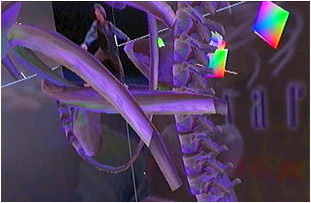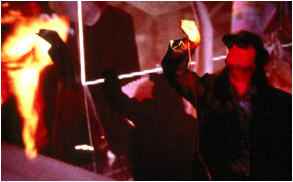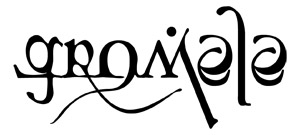
Gromala, Diane., "BioMorphic Typography," TypO Exhibition, Museum of Modern Art, Stockholm, Sweden, 2004.
Michael Terry, Jaroslav Tyman, Grace Ou, Diane Gromala. "Tesseract" SIGGRAPH Technicial Skteches, Los Angeles, 2004
Gromala, Diane., "BioMorphic Typography," TypO Exhibition, FACT (Foundation for Art & Creative Technology), Liverpool,
England, 2003.
Diane Gromala, Chris Shaw, "Expressing the Immeasurable: A Methodology for Developing a Visualization Tool for Patients'Assessments of Pain," CHI 2004 Workshop: Cross-dressing and Border Crossing: Exploring Experience methods Across Disciplines, Vienna April 2003 ( To be published as a short paper in the international refereed art researsch journal Convergence.
Nassim Jafariniami, Diane Gromala. "Meaningful Traces: Augmenting Children's drawings with Digital Media"
Ubicomp 2003, Seattle, October 2003.
David White, Greogory Abowd ,Diane Gromala. "Mobile Capture and Access for Children with Autism"
Ubicomp 2003, Seattle, October 2003.
Gromala, Diane., "Biomorphic Typography," TechnoPoetry Festival, Georgia Institute of Technology, April 1-2, 2002.
Gromala, Diane., Invited, with 17 artists, writes, and dancers to contribute to the collaboratiive work Entre. This piece was designed to establish an innovative, technologically - mediatedinterface between writing and dance. Plymouth Art Centre 28 June - 5 July 2002.
Gromala, Diane., Yacov Sharir, Chris Shaw.,"Dancing with the Virtual Dervish: Virtual Bodies II," Invited VR exhibit for SYNOPSIS II - THEOLOGIES, The National Museum of Contemporary Art, Athens, Greece.
Gromala, Diane, Hodges, Larry, Shaw, Chris., "The Meditation Chamber,University of Arizona, Center for Consciousness Studies,. Invited VR exhibit.
Â
Gromala, Diane., "Biomorphic Typography," TechnoPoetry Festival, Atlanta. Interactive Installation.
Shaw, Chris, Hong, Jin Young, Ribarsky, William, Gromala, Diane, Zhulin, Igor and Borodovsky, Mark. "Interactive Bioinformatics Browser" at Applying Bioinformatics from Genes to Systems, Georgia State University.
October 3-4, 2002.
Gromala, Diane., Immanent Bodies, University of California Los Angeles. Invited exhibit.
Gromala, Diane., Immanent Bodies, University of Santa Cruz. Invited exhibit.
Gromala, Diane., Excretia, The McLuhan Center, University of Toronto and the University of Catalonia, Barcelona. Invited video screening.
Gromala, Diane; Hodges, Larry; Shaw, Chris; Seay, Fleming., Interactive exhibit, The Meditation Chamber, SIGGRAPH, Los Angeles
Selected after rigorous adjudication for technological innovation in SIGGRAPH's Emerging Technologies venue. This work combines an immersive virtual environment with a biofeedback device. It blurs the boundaries among an artwork, an innovative use of technology, and an experimental, therapeutic modality for users with stress-related illnesses. Refereed.

Gromala, Diane., "Eating Eye, University of Bremen, Messe Centrum, Germany. Invited video screening.
Gromala, Diane., "Excretia, Exhibition of proof-of-concept for Biomorphic Typography, a major work-in-progress. The visual character of Biomorphic Typography responds in real-time to a userâs changing physical states. ISEA (International Society for Electronic Arts), Paris. Refereed.
Adams Art Gallery, Victoria University, Wellington, New Zealand
Invited (evening) video screening: Virtual Bodies"
Los Angeles Contemporary Exhibitions (LACE), Los Angeles
Invited (evening) video screening: "Virtual Subjectivities"
Gromala, Diane., Abject Subject, (as Putch Tu), Yale University, School of Art, New Haven, CT, Invited evening performance.
Western Front Gallery, Vancouver, Canada
Invited video screening: Virtual Bodies
Seattle Art Museum
Invited video screening: "Virtual Subjectivities"
Meany Theatre, The University of Washington, Seattle
Concert for New Music
Invited (evening) video screening: "Virtual Dervish"
Museum of Water, Lisbon
Peer-reviewed video screening: "Virtual Dervish"
York University, Toronto, Canada
Conference on Dance and Technology
Peer-reviewed video screening: "Virtual Bodies II"
The Center for Arts & Technology at Connecticut College
The Fifth Biennial Arts + Technology Symposium
Major peer-reviewed dance and theatrical VR performance and exhibition: with Yacov Sharir: "Virtual Bodies"
Banff Centre for the Arts, Banff, Canada
Fourth International Cyberspace Conference & Art and Virtual Environments Symposium
Major peer-reviewed dance and theatrical VR performance and exhibition, with Yacov Sharir: "Virtual Bodies"
Bogazici University, Istanbul, Turkey. 1994
Peer-reviewed video screening: "Virtual Dervish"
FISEA (Fourth International Society for Electronic Arts), 1994
Peer-reviewed interactive multimedia exhibit: "Virtual Dervish"
Siggraph'93, Anaheim Convention Center, California
Electronic Theatre
Peer-reviewed Video Screening: " Dancing with the Virtual Dervish: Virtual Bodiesâ. The Electronic Theatre jury chooses 15 videos to be screened, from over 600 submitted.
Gromala, Diane., Interactive, electronic costume and set design for the Sharir Dance Company's "Dogs", Performing Arts Center, Austin, Texas. Invited evening and weekend performances.
Gromala, Diane., Interactive, electronic costume design for the Sharir Dance Company's "The Egg", Theatre de la Suidad, Mexico City, Mexico. Invited evening and weekend performances.
Gromala, Diane., Interactive, electronic costume and set design for "The Egg", Suzanne Dellale International Dance Competition, Tel Aviv, Israel,. Evening and weekend performances. Refereed.
seamus (The Symposium for Electro-Acoustic Music), Austin,
Texas, Peer-reviewed interactive electronic exhibit: "Virtual Bodies"
Gromala, Diane., Interactive electronic costume design for the Sharir Dance Company's "The Egg," Carver Cultural Center, San Antonio, Texas, Invited evening and weekend performance.
Gromala, Diane., "Output", American Institute of Graphic Arts, Gallery & National Traveling Exhibition.
Created and directed this pioneering project in virtual communities, which involved several universities abroad. Exhibited in universities and art museums across the U.S. and Europe. Refereed.
Gromala, Diane., "The Yale Journal of World Affairs, American Institute of Graphic Arts, Gallery & National Traveling Exhibition, Exhibited in universities and art museums across the U.S.


Biomorphic Type
BioMorphic Typography is Gromala's term for a family of fonts that respond, in real-time, to a user's changing physical states, as measured by a biofeedback device. Rather than one typeface, it is a postmodern pastiche of many different fonts that are continually morphing. So, for example, the font "throbs" as the user's/writer's heart beats. In this way, users become aware of their autonomic states. This project is part of a larger initiative, Design for the Senses. The goal is to develop new approaches to experiential design that focus on the senses and the history of the body.
Living Book of the Senses

(semi-finalist for Discover's award in technological innovation)
*The Living Book of Senses* is a new media form that extends the traditional book into a radically new sensorially interactive experience.
Users are able to see their physical surroundings while dynamically engaging with three-dimensional mixed realities which appear on their headsets. Users can interact with the book in dynamic ways that go beyond mere clicking and pointing. They can ask the book questions (via voice recognition), and can influence the book through their sensory (bio) feedback. Thus, the book becomes a powerful new sensory experience.
Users wear a headset/head-tracker/color camera system that enables them to see physical reality enhanced with a virtual reality overlay. The camera inputs images/patterns and feeds them back into the ARToolkit software which then displays digital information associated with the physical markers onto the headset. The ARToolkit can calculate camera position and orientation relative to physical markers in real time for video-mediated reality.
Each reader can view AR scenes from their own visual perspective. Users can fly into the immersive world and see each other represented as avatars in the same virtual scene. Readers remaining in the AR scene have a birds'-eye view of other readers as miniature avatars in the virtual scene displayed through their headset. User-controlled dialog with the book elicits responses/answers from the book (expressed in digital data: visual, textual, auditory). As the users simultaneously interact with the book in the physical and virtual realms, the book responds to individual and multiple physical states (via biofeedback) to express resulting changes in narrative. The narrative is a cultural history of the senses.
The Living Book is an enhanced learning tool that enables users to become aware of their sensorial experience and bodily states. Collaborations using this book enable distance learning with multiple user interactions. The living book can be used in any narrative-based media to create dynamic communication between any number of people.

SIGGRAPH Art Gallery

Art Gallery Chair and Curator (selected in competition with eleven leading artists and curators). The Art Gallery exhibition at SIGGRAPH is the most respected venue for electronic art within the converging communities of Computer Science and Electronic Art. It occurs within the context of the ACMâs (Association for Computing Machinery) special interest group on computer graphics and interactive techniques. The millennial Art Gallery exhibition required two years of planning.
Responsibilities included:
- Curating the work of 60 internationally-recognized leaders in electronic art and design
- Organizing jury for adjudication of papers and negotiating publication contract with leading journal
- Space planning for the 87,000 square feet exhibition area
- Managing the $92,000 budget
- Organizing extensive donations
- Coordinating media coverage
This millennial exhibition was noteworthy in several respects. First, it was the largest exhibition of interactive electronic art in the thirty year history of SIGGRAPH. Second, talks by artists, along with panels of internationally-recognized artists, theorists, and scholars were carefully organized and integrated with all other SIGGRAPH venues. Third, the Art Gallery was notably expanded by the organization of peer-reviewed essays published in a negotiated, three-year contract with the leading journal in the field, Leonardo. Finally, extensive coverage by the media included international television coverage, as well as articles in USAToday and a front page article in the Art & Leisure Section of The New York Times.
This curatorial work, distinctive in its emphasis on accessibility and critical analyses, will lead to a co-authored book, with Jay David Bolter (under contract, MIT Press; refer to E. works-in-progress).
Eating Eye
Eating Eye is an expedition in visual culture. It focusses on the translation of the Maori culture in post colonial, modern New Zealand. It examines the taxonomy of the Maori culture in Te Papa, the National Museum of NZ and looks at a television commercial for Addidas, which appropriates the Haka, a Maori War dance.
Dancing with the Virtual Dervish : Virtual Bodies
Co-creators and co-producers: Diane Gromala (50%) and Yacov Sharir (50%) This landmark artwork in virtual reality (VR) received unprecedented art funding from the National Department of Communication, Canada, and the Banff Center for the Arts. It was one of six selected from an international pool of collaborative groups which includes the foremost media artists and computer scientists working with virtual and communications technologies. This artwork was one of the very first in VR.
The scope of the work required four computer scientists and six art technicians over two years. The computing demands of the new medium necessitated 3 forms of dissemination: major dance/theatrical performances, interactive exhibitions, and large scale video screenings. As a major dance and theatrical production, Dancing with the Virtual Dervish: Virtual Bodies premiered at the Banff Centre for the Arts, with two subsequent peer-reviewed performances at international art venues. This work resulted in numerous performances, exhibitions, and screenings, as well as lectures, peer-reviewed publications, and broadcasts on the Discovery Channel and the BBC. It is frequently cited in books (art and computer science), journals, and online sites.







